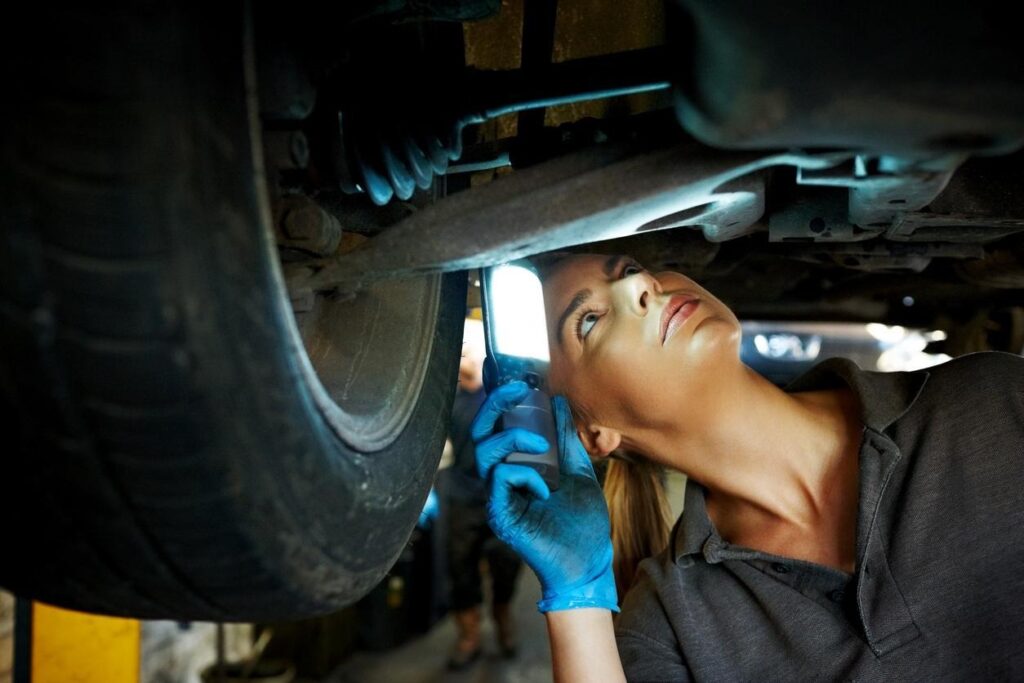If you’ve just spent a few thousand kays wrestling corrugations, hopping creek beds, and kicking up enough dust to keep the mozzies at bay until Christmas, spare a minute for the unsung hero beneath your rig. Your suspension kit has copped every knock, twist, and full‑compression moment on that track.
Before you sling the swag on the clothesline and crack a cold one, give those components a proper once‑over. A short inspection now beats a snapped coil tower or wandering steering later.
We’ll step through the must‑look areas, explain what healthy parts should look and feel like, and flag the warning signs. Make sure to keep all these in mind when you’re in the market for suspension kits.
Look First, Feel Later: A Quick Visual Scan
Start with the simplest tool in the shed—your eyes. Park on level ground, walk a slow lap, and pay close attention to symmetry. If one corner sits lower, it’s not just the esky still on board; something may have sagged or bent. Here’s what to watch for:
- Uneven ride height from side‑to‑side or front‑to‑rear
- Damp or oily streaks down the shock bodies
- Control arms, sway‑bar links, or struts sitting at odd angles
- Bushings that look chewed, torn, or missing altogether
Even a subtle lean can be the tip‑off to a collapsed coil or a cracked leaf. Returned home loaded to the gunwales? Let the wagon settle overnight before judging height. This way, you’re not blaming the suspension for yesterday’s camp oven.
Check the Shocks: More Than Just Leaks
Shock absorbers keep each tyre pressed onto the dirt so your brakes, steering, and diff locks can actually work. Assess them in three quick steps:
- Oil seepage – A faint mist around the shaft is sometimes normal, but a run of oil down the body means the internal seal has spat the dummy.
- Bounce test – Give each corner a firm shove. If the vehicle rebounds twice or more, that shock has lost its damping mojo.
- Noise patrol – Idle over a speed bump with the window down. A clunk often means the top bush or lower pin is flogged out, not necessarily the shock itself.
Bushings, Bolts, and Brackets: The Quiet Killers
These small bits cop relentless torque and vibration, yet they’re the first things we overlook. Put a torch on them:
- Rubber or polyurethane bushings should be supple and free of radial cracks. A split bush not only squeaks like a galah but lets metal parts wander, trashing alignment.
- Bolt torque matters. Grab a calibrated torque wrench and confirm critical fasteners, such as shock mounts, control‑arm pivots, and spring seats, haven’t walked loose after endless corrugations.
- Mounting brackets deserve a close squiz for faint rust trails or hairline fractures near welds. Early rust stains often mark fresh metal movement.
Do you hear a groan on right‑handers? Nine times out of 10 the culprit’s a flogged‑out lower‑control‑arm bush. Nip it in the bud and your chassis will thank you later.
Coils and Leaf Springs: Are They Holding Their Shape?
Springs carry the bulk weight, and they can lose form long before they snap. With coils, eye the spacing: gaps should be even. Tight coils at one end and stretched gaps at the other mean the steel’s taken a set. Surface rust where powder coat has chipped hints at metal‑to‑metal chatter. Leaf packs tell their own story: leaves fanning apart, scuff marks at the tips, or a noticeably flatter arc than you left with all spell fatigue.
If the back end sits low even after you’ve ditched the jerries, you’re pushing your luck. Replace tired springs rather than stacking spacer blocks. Band‑aids won’t carry you across bulldust ruts.
Alignment After Off‑Roading: Not Just for Bitumen Drivers
A pothole‑laden bush track can nudge your alignment out without you noticing on the dirt. Back on the highway, that shift shows up as feathered edges on the tyres or a steering wheel that’s half a spoke off‑centre. Ignore it and you’ll cook the tyre shoulders before the next service.
Consider a quick toe‑and‑camber check at your local tyre joint. This often exposes subtle suspension sag or a slightly bent tie rod you missed earlier. Think of it as knocking your wheels back into line before the next adventure rather than a purely road‑car chore.
Steering Linkages and Tie Rods: Ever Crucial
Every corrugation sends a hammer blow up the steering system, so lift the front, grab each tyre at 9 and 3 o’clock, and give it a wiggle. More than a whisper of play? That’s usually a worn inner or outer tie‑rod end.
Spin the wheel while you’re there; a faint click could be a ball joint crying out for grease or replacement. Check the steering damper for stone kisses or oily dribbles. When it fades, shimmy creeps in. If the ute feels a bit ‘floaty’ at highway pace, odds are one of these joints has loosened its grip.
Treat Your Suspension Like a Mate—Look After It
Underneath the bull dust and stone dents, your suspension kit is the best cobber you’ve got on the tracks. It soaks up the hits, keeps the tyres planted, and gives you the confidence to send it over that last rise.
A post‑trip inspection is a quick yarn with the parts that carried you home. Give them a clean, tighten what’s worked loose, replace anything tired, and you’ll head off next time knowing your undercarriage is solid as the rock it rides over!



